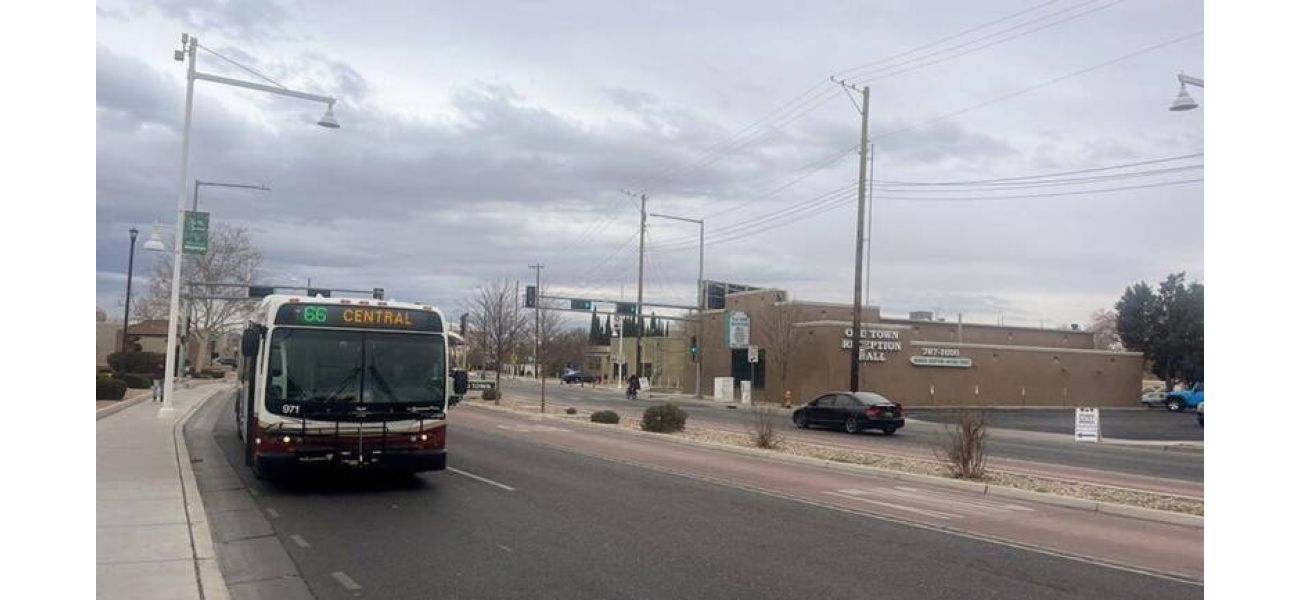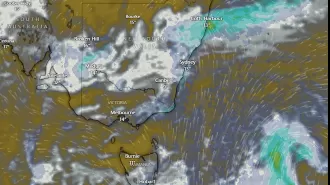2 years after Albuquerque removed bus fares, free transit in the city is still going strong.
In November 2023, Albuquerque became one of the largest U.S. cities to permanently implement zero-fare transit.
August 1st 2025.

Sabina Wohlmuth used to spend her days walking long distances in Albuquerque, often covering two or three miles at a time. She relied on the bus as her main form of transportation, but when she didn't have enough money for the fare, she would choose to walk instead.
According to Wohlmuth, the cost of a one-way trip may seem insignificant to some, but for those who are homeless and struggling financially, every dollar counts. However, things have changed for Wohlmuth now that Albuquerque has implemented a zero-fare transit system since November 2023. This move has made it one of the largest cities in the US to offer free public transportation. And for Wohlmuth, it has made a significant difference.
Now, she takes the bus daily to get to her job at McDonald's, run errands, and go to the sober living facility where she stays. And the best part? She doesn't have to pay a single cent for these rides. According to transit officials and advocates, the zero-fare program is achieving its intended goal of serving the city's lowest-income residents. And unlike some other cities that have reverted their plans to make transit free, Albuquerque is committed to keeping the program in place.
Leslie Keener, the director of the city's transit department, believes that offering free public transportation is a form of public service that can have a positive impact on the lives of those who rely on it. She sees it as a means to promote accessibility and mobility, giving people the opportunity for upward movement.
For many residents of Albuquerque, public transportation is not just a means of getting from one place to another – it's a lifeline. A study by Next City found that nearly 90% of bus riders in Albuquerque have an annual household income of less than $35,000, and a similar percentage do not have access to a vehicle. This is why Christopher Ramirez, the co-founder and executive director of Together for Brothers, believes that transit equity is crucial. He sees it as a way to provide necessary resources to those who need it most.
Together for Brothers is a community organization that conducted a community health impact assessment in 2017, which highlighted the need for advocating for transit equity. Since 2019, the organization has led a coalition to push for free public transportation in Albuquerque. And for many residents like Charles Battiste and Q, who rely on the bus daily, this has been a game-changer.
Charles Battiste, who was on his way to a hotel where he had recently secured temporary housing, and Q, who was on their way to pick up medicine, are just two examples of individuals who rely on the bus for basic needs such as medical appointments, social service providers, and work. Rachel Biggs, the chief strategy officer at Albuquerque Health Care for the Homeless, explains that transportation is one of the biggest barriers for their clients in accessing essential services and finding solutions to homelessness.
Previously, Biggs' organization spent around $50,000 a year to purchase bus passes for clients, which proved to be a cumbersome and time-consuming process. However, with the implementation of free public transit, clients no longer have to go through the hassle of picking up daily bus passes and can simply hop on and off the bus as needed. This has increased access to services and resources for those experiencing homelessness.
For other Albuquerque residents, free public transportation has become a vital lifeline when money is tight or other modes of transportation are not available. One 67-year-old woman, who recently had her car repossessed due to financial difficulties, appreciates the convenience and cost-saving benefits of free public transit. She notes that it's a welcome change from having to pay for gas, insurance, and other expenses associated with driving.
Sabina Wohlmuth used to spend her days trekking long distances across Albuquerque, often walking two to three miles at a time. As someone who relied on the bus for transportation, she would sometimes choose to walk instead of paying the fare when she was short on cash. While the fare was only a dollar for a one-way trip, for someone who was homeless and struggling financially, it was a significant amount.
But now, things have changed for Wohlmuth. She takes the bus every day to get to her job at McDonald's, run errands, and go to the sober living facility where she stays. And the best part? She no longer has to worry about paying for bus fare, thanks to Albuquerque's decision to make public transit free in November 2023. This bold move has made Albuquerque one of the largest cities in the United States to implement a zero-fare transit system. And according to transit officials and advocates, the program has been a success in serving the needs of the city's lowest-income residents.
Leslie Keener, the director of Albuquerque's transit department, believes that providing free public transit is a crucial public service, especially for those who are struggling to make ends meet. She sees it as a way to increase access and mobility, ultimately giving people the opportunity for upward movement in their lives. This sentiment is echoed by Christopher Ramirez, the co-founder and executive director of Together for Brothers, a community organization that has been advocating for transit equity in Albuquerque since 2017.
Ramirez believes that transit equity is about providing resources to those who need it the most, and then building upon that foundation to improve other aspects of public transit. He and his organization have been leading a coalition to push for free transit in Albuquerque since 2019. Their efforts have been especially beneficial for the city's homeless population, many of whom rely on the bus to get to essential appointments, social services, work, and to visit loved ones.
Charles Battiste and Q are two such individuals who take the bus every day. For Battiste, the bus takes him from his methadone treatment program to the hotel where he recently secured temporary housing. Meanwhile, Q, who has been unhoused since they were 18, uses the bus to get to a hospital for medication. For both of them, free public transit has been a lifeline, providing them with the necessary mobility to survive and improve their lives.
Rachel Biggs, the chief strategy officer at Albuquerque Health Care for the Homeless, can attest to the importance of free public transit for her clients. She explains that transportation is often one of the top barriers for their clients in accessing healthcare, jobs, housing, and other solutions to homelessness. With the city's high poverty rate and growing number of transit-dependent residents, free public transit has become a crucial resource for many individuals.
In the past, Biggs' organization would spend around $50,000 a year on bus passes for their clients. However, this system was cumbersome and time-consuming, with clients having to shuttle from the city's shelter to their office to pick up a daily pass before heading to their destinations. This was not a feasible long-term solution, as many people experiencing homelessness would often lose their passes during encampment sweeps. But with free public transit, Biggs' clients can now hop on and off the bus without any obstacles, allowing them to access the services they need to end their homelessness.
For other Albuquerque residents, free public transit has been a vital lifeline in times of financial struggle. One 67-year-old woman, who recently had her car repossessed due to financial difficulties, appreciates the free option, especially after years of paying for insurance and other transportation expenses. Overall, the decision to make public transit free in Albuquerque has had a positive impact on the lives of its residents, particularly those who are most in need.
According to Wohlmuth, the cost of a one-way trip may seem insignificant to some, but for those who are homeless and struggling financially, every dollar counts. However, things have changed for Wohlmuth now that Albuquerque has implemented a zero-fare transit system since November 2023. This move has made it one of the largest cities in the US to offer free public transportation. And for Wohlmuth, it has made a significant difference.
Now, she takes the bus daily to get to her job at McDonald's, run errands, and go to the sober living facility where she stays. And the best part? She doesn't have to pay a single cent for these rides. According to transit officials and advocates, the zero-fare program is achieving its intended goal of serving the city's lowest-income residents. And unlike some other cities that have reverted their plans to make transit free, Albuquerque is committed to keeping the program in place.
Leslie Keener, the director of the city's transit department, believes that offering free public transportation is a form of public service that can have a positive impact on the lives of those who rely on it. She sees it as a means to promote accessibility and mobility, giving people the opportunity for upward movement.
For many residents of Albuquerque, public transportation is not just a means of getting from one place to another – it's a lifeline. A study by Next City found that nearly 90% of bus riders in Albuquerque have an annual household income of less than $35,000, and a similar percentage do not have access to a vehicle. This is why Christopher Ramirez, the co-founder and executive director of Together for Brothers, believes that transit equity is crucial. He sees it as a way to provide necessary resources to those who need it most.
Together for Brothers is a community organization that conducted a community health impact assessment in 2017, which highlighted the need for advocating for transit equity. Since 2019, the organization has led a coalition to push for free public transportation in Albuquerque. And for many residents like Charles Battiste and Q, who rely on the bus daily, this has been a game-changer.
Charles Battiste, who was on his way to a hotel where he had recently secured temporary housing, and Q, who was on their way to pick up medicine, are just two examples of individuals who rely on the bus for basic needs such as medical appointments, social service providers, and work. Rachel Biggs, the chief strategy officer at Albuquerque Health Care for the Homeless, explains that transportation is one of the biggest barriers for their clients in accessing essential services and finding solutions to homelessness.
Previously, Biggs' organization spent around $50,000 a year to purchase bus passes for clients, which proved to be a cumbersome and time-consuming process. However, with the implementation of free public transit, clients no longer have to go through the hassle of picking up daily bus passes and can simply hop on and off the bus as needed. This has increased access to services and resources for those experiencing homelessness.
For other Albuquerque residents, free public transportation has become a vital lifeline when money is tight or other modes of transportation are not available. One 67-year-old woman, who recently had her car repossessed due to financial difficulties, appreciates the convenience and cost-saving benefits of free public transit. She notes that it's a welcome change from having to pay for gas, insurance, and other expenses associated with driving.
Sabina Wohlmuth used to spend her days trekking long distances across Albuquerque, often walking two to three miles at a time. As someone who relied on the bus for transportation, she would sometimes choose to walk instead of paying the fare when she was short on cash. While the fare was only a dollar for a one-way trip, for someone who was homeless and struggling financially, it was a significant amount.
But now, things have changed for Wohlmuth. She takes the bus every day to get to her job at McDonald's, run errands, and go to the sober living facility where she stays. And the best part? She no longer has to worry about paying for bus fare, thanks to Albuquerque's decision to make public transit free in November 2023. This bold move has made Albuquerque one of the largest cities in the United States to implement a zero-fare transit system. And according to transit officials and advocates, the program has been a success in serving the needs of the city's lowest-income residents.
Leslie Keener, the director of Albuquerque's transit department, believes that providing free public transit is a crucial public service, especially for those who are struggling to make ends meet. She sees it as a way to increase access and mobility, ultimately giving people the opportunity for upward movement in their lives. This sentiment is echoed by Christopher Ramirez, the co-founder and executive director of Together for Brothers, a community organization that has been advocating for transit equity in Albuquerque since 2017.
Ramirez believes that transit equity is about providing resources to those who need it the most, and then building upon that foundation to improve other aspects of public transit. He and his organization have been leading a coalition to push for free transit in Albuquerque since 2019. Their efforts have been especially beneficial for the city's homeless population, many of whom rely on the bus to get to essential appointments, social services, work, and to visit loved ones.
Charles Battiste and Q are two such individuals who take the bus every day. For Battiste, the bus takes him from his methadone treatment program to the hotel where he recently secured temporary housing. Meanwhile, Q, who has been unhoused since they were 18, uses the bus to get to a hospital for medication. For both of them, free public transit has been a lifeline, providing them with the necessary mobility to survive and improve their lives.
Rachel Biggs, the chief strategy officer at Albuquerque Health Care for the Homeless, can attest to the importance of free public transit for her clients. She explains that transportation is often one of the top barriers for their clients in accessing healthcare, jobs, housing, and other solutions to homelessness. With the city's high poverty rate and growing number of transit-dependent residents, free public transit has become a crucial resource for many individuals.
In the past, Biggs' organization would spend around $50,000 a year on bus passes for their clients. However, this system was cumbersome and time-consuming, with clients having to shuttle from the city's shelter to their office to pick up a daily pass before heading to their destinations. This was not a feasible long-term solution, as many people experiencing homelessness would often lose their passes during encampment sweeps. But with free public transit, Biggs' clients can now hop on and off the bus without any obstacles, allowing them to access the services they need to end their homelessness.
For other Albuquerque residents, free public transit has been a vital lifeline in times of financial struggle. One 67-year-old woman, who recently had her car repossessed due to financial difficulties, appreciates the free option, especially after years of paying for insurance and other transportation expenses. Overall, the decision to make public transit free in Albuquerque has had a positive impact on the lives of its residents, particularly those who are most in need.
[This article has been trending online recently and has been generated with AI. Your feed is customized.]
[Generative AI is experimental.]
0
0
Submit Comment





